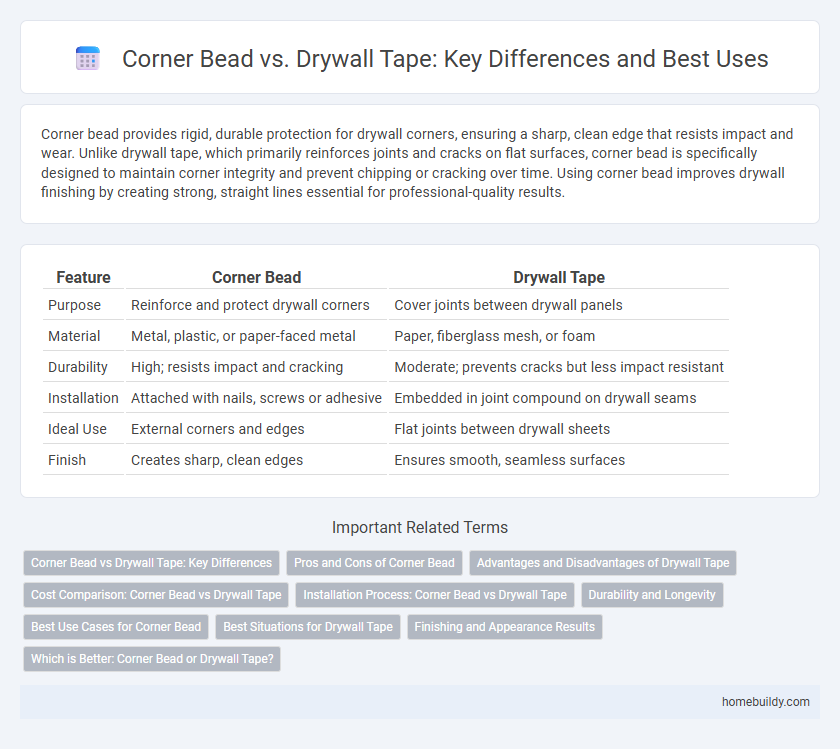Corner bead provides rigid, durable protection for drywall corners, ensuring a sharp, clean edge that resists impact and wear. Unlike drywall tape, which primarily reinforces joints and cracks on flat surfaces, corner bead is specifically designed to maintain corner integrity and prevent chipping or cracking over time. Using corner bead improves drywall finishing by creating strong, straight lines essential for professional-quality results.
Table of Comparison
| Feature | Corner Bead | Drywall Tape |
|---|---|---|
| Purpose | Reinforce and protect drywall corners | Cover joints between drywall panels |
| Material | Metal, plastic, or paper-faced metal | Paper, fiberglass mesh, or foam |
| Durability | High; resists impact and cracking | Moderate; prevents cracks but less impact resistant |
| Installation | Attached with nails, screws or adhesive | Embedded in joint compound on drywall seams |
| Ideal Use | External corners and edges | Flat joints between drywall sheets |
| Finish | Creates sharp, clean edges | Ensures smooth, seamless surfaces |
Corner Bead vs Drywall Tape: Key Differences
Corner bead provides rigid, durable reinforcement to drywall corners, preventing cracks and ensuring a sharp, clean edge. Drywall tape, typically paper or fiberglass mesh, is used to cover seams and joints, creating a smooth surface for finishing but lacks the structural strength of corner bead. Choosing corner bead is essential for high-impact areas requiring protection, while drywall tape is suited for flat surface joint reinforcement.
Pros and Cons of Corner Bead
Corner bead offers superior durability and impact resistance compared to drywall tape, making it ideal for protecting and reinforcing external corners. Its metal or plastic composition ensures a crisp, straight edge that resists cracking and chipping, but installation requires more precision and tools, potentially increasing labor time. Unlike drywall tape, corner bead cannot be used on inside corners and may require additional finishing coats to achieve a seamless appearance.
Advantages and Disadvantages of Drywall Tape
Drywall tape provides a smooth surface for drywall joints with easy application and flexibility, reducing the risk of cracking in curved or irregular corners. However, drywall tape lacks the structural reinforcement and impact resistance offered by metal or vinyl corner bead, making it less durable in high-traffic areas. Compared to corner bead, drywall tape requires more maintenance over time due to its vulnerability to dents and chipping.
Cost Comparison: Corner Bead vs Drywall Tape
Corner bead typically costs more upfront than drywall tape due to its rigid materials like metal or plastic, which provide durable edge protection. Drywall tape, often made of paper or fiberglass mesh, is less expensive but may require additional coats of joint compound and sanding, increasing labor time and overall cost. When factoring in long-term durability and finish quality, corner bead can offer better value despite its higher initial price.
Installation Process: Corner Bead vs Drywall Tape
Corner bead installation involves fastening a rigid metal or plastic strip to drywall corners using nails, screws, or adhesive, followed by applying joint compound for a crisp, durable edge. Drywall tape requires embedding a paper or fiberglass mesh tape into a wet layer of joint compound, which is then layered and sanded to smooth seams between drywall sheets. Compared to drywall tape, corner bead offers a more straightforward installation process with increased protection against corner damage.
Durability and Longevity
Corner bead provides superior durability and longevity compared to drywall tape due to its rigid material, often metal or PVC, which reinforces and protects drywall corners from impact and wear. Unlike drywall tape, which can crack or peel over time, corner bead maintains structural integrity and prevents chipping or damage in high-traffic areas. Its resistance to moisture and physical stress ensures a longer-lasting, cleaner finish on wall corners.
Best Use Cases for Corner Bead
Corner bead provides superior protection and durability for drywall corners compared to drywall tape, making it ideal for high-traffic areas and exterior corners. Its rigid metal or plastic construction reinforces edges against impacts, preventing cracking and chipping over time. Best used in residential and commercial applications requiring long-lasting corner strength, corner bead ensures a smooth, professional finish that maintains structural integrity.
Best Situations for Drywall Tape
Drywall tape is best suited for repairing small cracks and seams on drywall surfaces where flexibility and easy application are critical. It works well on flat joints and inside corners that do not require the rigid protection provided by corner bead. For areas needing smooth transitions without added bulk, drywall tape offers a seamless finish ideal for low-impact zones.
Finishing and Appearance Results
Corner bead provides a durable, crisp edge for drywall corners, enhancing finishing and delivering a smooth, professional appearance. Compared to drywall tape, corner bead resists cracking and dents better, maintaining sharp lines over time. This results in cleaner, more precise corners that improve overall visual appeal in interior spaces.
Which is Better: Corner Bead or Drywall Tape?
Corner bead provides superior protection and durability for external drywall corners, preventing cracks and dents that drywall tape alone cannot resist. Drywall tape is better suited for internal seam reinforcement and prevents joint cracking but lacks the rigidity corner bead offers for corners. For best results, professional drywall installation often combines both: corner bead for crisp, durable edges and drywall tape for smooth interior seams.
corner bead vs drywall tape Infographic

 homebuildy.com
homebuildy.com